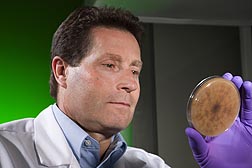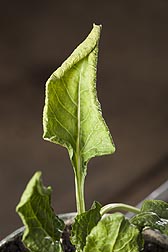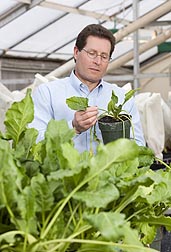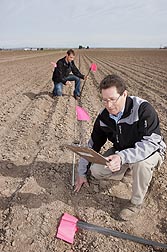A Search for the Sweet Spot in Sugar BeetProduction
|
|
The whole point of growing sugar beets is to produce sugar.
But once the beets are harvested and stored for processing—usually in huge piles that can weigh thousands of tons—they slowly start to decay, which lowers their sucrose levels.
Roots store sugar even more poorly if they originate from fields infested with the virus that causes rhizomania, a disease that also severely affects yield. Resistance genes in sugar beet help protect the plant from rhizomania, but some strains of the virus have evolved to overcome one of the resistance genes, Rz1.
“The economic loss from damage to stored beets is quite large,” says plant pathologist Carl Strausbaugh, who works at the Agricultural Research Service’s Northwest Irrigation and Soils Research Laboratory in Kimberly, Idaho. “For instance, if we could figure out how to save even 1 percent of the sucrose in beets during storage, it could save producers in the Pacific Northwest $4 million every year.”
|
|
The Best Beets
For years, Strausbaugh and ARS molecular biologist Imad Eujayl have studied sugar beets from the field—where a strong wind can twist tiny seedlings right out of the ground—to the processing factory. Eujayl also works at the ARS laboratory in Kimberly.
The two researchers have made several key findings about the pathology of rhizomania, which is caused by beet necrotic yellow vein virus (BNYVV). Some of their evidence suggests that the right genes can help keep beets from going bad and losing sugar during storage.
The team grew around 30 commercial sugar beet varieties in 2006 and 2007 in fields that were naturally infested with BNYVV. Then they collected samples from each variety—all of which showed some evidence of typical rhizomania infection—and calculated the average sugar content of each variety after at least 4 months in storage.
The scientists found that roots from some varieties stored indoors had lost as much as 100 percent of their recoverable sugar content, and roots from some varieties stored outdoors had lost as much as 60 percent.
The scientists also observed that the beet varieties that exhibited the greatest rhizomania resistance and the best storability—indicated by the lowest levels of fungal growth and lowest levels of weight loss from root damage—also had the highest sugar levels. Breeders can use this information to develop new varieties that retain more sugar during storage, based on selecting for storability and improved resistance to rhizomania.
|
|
Appearances Are Deceiving
Strausbaugh’s studies also established a whole new model that explains how pathogens succeed in infecting healthy sugar beets.
“The fungusRhizoctonia solani was thought to be responsible for most of the root rot we see in Idaho sugar beet, and it does have a certain amount of impact,” Strausbaugh says. “But we found that most root mass is lost to bacterial activity, not fungal activity.”
Along with plant geneticist Anne Gillen, who now works in the ARS Crop Genetics Research Unit in Stoneville, Mississippi, Strausbaugh confirmed that the gram-positive bacterium Leuconostoc mesenteroides subsp. dextranicum is responsible for around 70 percent of the loss in beet root mass. “We showed that L. mesenteroides starts the fermentation process in the root mass, which then creates a pathway for other organisms to come in and cause spoilage,” Strausbaugh says.
This might sound like business as usual between successful microbes, but results from this research—which were published in Plant Disease in 2008—helped to confirm that gram-positive bacteria like L. mesenteroides can be the first pathogen—and often the most damaging one—involved in the root rot process.
|
|
Curtailing Curly Top
Every year, western U.S. sugar beet producers also battle beet curly top virus, which is transmitted by beet leafhoppers. Back in the lab, Eujayl set out to develop a set of genetic markers that plant breeders could use in developing curly top-resistant sugar beet varieties.
Strausbaugh and Eujayl started by infecting 200 wild, commercial, or other different sugar beet varieties with curly top. Then they ranked each plant according to the severity of its physical responses to infection. When these visible physical responses are the result of the underlying genetics, they are called “phenotypic” traits.
Eujayl then analyzed the phenotypic data with 1,000 sugar beet DNA genetic markers that had been identified by a process called “diversity array technology” (DArT). He analyzed these markers to identify which ones were associated with the disease-resistance genes. The analysis indicated that 11 of these genetic markers were significantly associated with resistance to curly top—and that 5 of the 11 markers were linked to the phenotypic resistance trait.
|
|
“The DArT markers are abundant compared to other marker systems, like simple sequence repeat markers or single nucleotide polymorphism markers. Using DArT allowed us to identify many markers that we would not have found with the other techniques,” Eujayl says.
Strausbaugh also conducted a 2-year field study in southern Idaho to see whether curly top damage could be controlled by treating sugar beet seeds with insecticides, which controls the leafhopper that transmits the virus. Working with colleagues, he treated seeds from four sugar beet cultivars with one of two commercial pesticides, Poncho Beta or Gaucho.
The researchers observed that both insecticides reduced the incidence of curly top in the fields. But as the growing season progressed, plants grown from seeds treated with Poncho Beta produced higher yields, especially in hybrids that were more vulnerable to the disease.
Averaged across all tested cultivars, the recoverable sugar content increased 21 percent. Because of that substantial increase in yield, the U.S. Environmental Protection Agency used these data sets to issue an emergency exemption for the use of Poncho Beta. Since genetic resistance to curly top is not always available, Poncho treatment will allow for near-normal levels of sugar beet production, and it also provides an excellent research tool for breeders to use in evaluating other plant diseases.
“The environmental footprint from using foliar insecticides to protect young sugar beet plants is very large,” Strausbaugh says. “However, treating the seed with Poncho leaves a much smaller environmental footprint and can protect young plants through the early season growth stages, when they’re highly susceptible to curly top.”—By Ann Perry, Agricultural Research Service Information Staff.
This research is part of Plant Genetic Resources, Genomics, and Genetic Improvement (#301) and Plant Diseases (#303), two ARS national programs described at www.nps.ars.usda.gov.
Carl Strausbaugh and Imad Eujayl are with the USDA-ARS Northwest Irrigation and Soils Research Laboratory, 3793 North 3600 East, Kimberly, ID 83341; (208) 423-6594 [Strausbaugh], (208) 423-6544 [Eujayl].
"A Search for the Sweet Spot in Sugar BeetProduction" was published in the January 2012 issue of Agricultural Research magazine.











